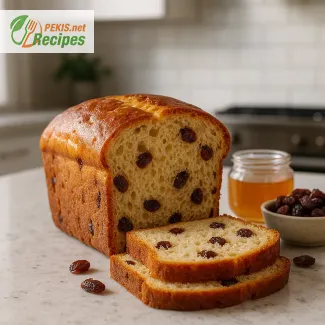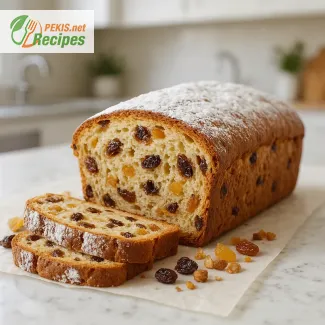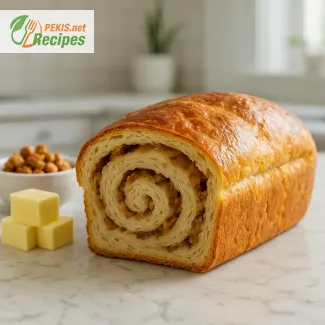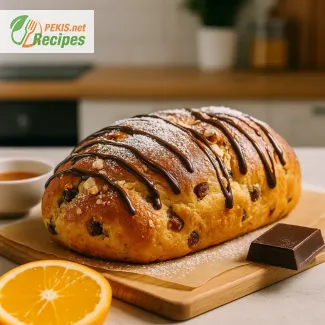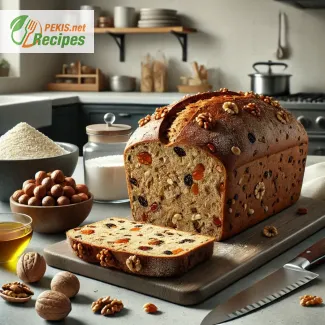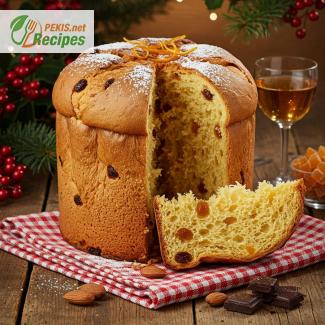
Traditional Italian Panettone: A Timeless Holiday Indulgence
The rich history and irresistible charm of panettone
Few baked goods embody the spirit of Christmas quite like the Italian panettone. This traditional sweet bread, with its light, airy texture and luxurious flavor, has been a festive centerpiece in Italian homes for centuries. Originating in Milan, panettone is much more than just a holiday treat—it is a symbol of family gatherings, warmth, and celebration. The combination of candied fruits, raisins, and a delicately sweet dough makes it a truly unique dessert, enjoyed worldwide during the holiday season.
But what makes panettone so special? Unlike a typical cake or bread, this festive loaf undergoes a long and meticulous preparation process that includes multiple rises, a slow fermentation, and careful baking techniques to achieve its signature tender crumb and dome-shaped top. The balance between a soft, cloud-like texture and rich flavors makes it an unmistakable delicacy cherished by pastry enthusiasts.
A luxurious holiday tradition with deep Italian roots
Panettone's origins can be traced back to the Renaissance era in Milan, where it was initially considered a luxury item reserved for noble families and special occasions. Over the centuries, this delicacy became more accessible, evolving into a staple of Christmas festivities not only in Italy but across the globe. Today, it is often given as a holiday gift, beautifully wrapped and enjoyed with a glass of spumante, vin santo, or a cup of espresso.
The traditional recipe has remained largely unchanged, requiring the perfect balance of high-quality flour, fresh eggs, butter, natural yeast, and dried fruits. The result is an elegant, fragrant bread that carries hints of vanilla, citrus zest, and delicate spices, making it irresistible from the very first bite.
The art of making panettone at home
While many people purchase artisanal or commercial panettone during the holidays, there is something truly rewarding about baking this masterpiece from scratch. The process requires patience, precision, and a bit of expertise, as the dough needs ample time to rise and develop complex flavors. Achieving the characteristic soft and airy texture relies on using a traditional sourdough starter or a carefully cultivated pre-ferment, which helps create the bread’s distinct fluffiness and depth of taste.
Beyond its traditional form, panettone can also be customized with chocolate chips, nuts, liqueur-infused fruits, or even a dusting of powdered sugar, making it a versatile treat that suits different preferences. Whether enjoyed toasted with butter, paired with a sweet wine, or transformed into a decadent French toast, this iconic Christmas bread continues to bring joy to every festive table.
An irresistible blend of texture and flavor
One of the most fascinating aspects of panettone is its unique structure—a perfect harmony of lightness and richness. The secret lies in the slow leavening process, which develops a beautifully soft interior while keeping the outer crust golden and slightly crisp. The addition of butter and eggs enhances its tenderness, while the subtle notes of vanilla and citrus elevate its overall complexity.
Each bite offers a delightful contrast: the silky, airy crumb combined with chewy raisins and candied orange peel creates a symphony of textures. The flavors unfold gradually, leaving behind a delicate sweetness that lingers long after the last bite.
The perfect festive gift and centerpiece
In Italy, gifting a beautifully wrapped panettone is considered a symbol of goodwill and prosperity. Many bakeries and pastry shops offer elegant, hand-crafted versions, often adorned with ribbons and gold-foil packaging. Whether given as a present or shared at a family feast, this Italian classic is a testament to the rich culinary heritage of Italy and the joy of celebrating the holiday season with loved ones.
Panettone’s versatility also makes it an ideal dessert for creative recipes. Leftover slices can be transformed into bread pudding, trifles, or even ice cream sandwiches, ensuring that no crumb goes to waste. With its fragrant aroma, soft texture, and timeless appeal, panettone continues to reign as one of the most beloved holiday traditions, bringing warmth and indulgence to tables around the world.
- Prepare the starter: In a bowl, mix warm milk, yeast, sugar, and flour. Stir well, cover with a cloth, and let it rise for 30 minutes until frothy.
- Soak the dried fruit: In a small bowl, soak the mixed dried fruits in dark rum and set aside. This enhances flavor and keeps the fruit plump.
- Prepare the dough: In a large mixing bowl, combine flour, sugar, and salt. Add the eggs one by one, mixing continuously. Then, incorporate the risen starter, vanilla extract, honey, and citrus zest. Mix well.
- Kneading and incorporating butter: Knead the dough for 10 minutes until elastic. Gradually add softened butter, kneading continuously for another 10 minutes until fully incorporated and smooth.
- First proofing: Place the dough in a greased bowl, cover with a cloth, and let it rise in a warm place for 2 hours or until it doubles in size.
- Adding the soaked fruit: Drain the dried fruit and gently knead it into the dough until evenly distributed.
- Second proofing: Transfer the dough into a panettone mold (or high-sided round baking tin lined with parchment paper). Cover and let it rise for another 60-90 minutes until it reaches the top of the mold.
- Prepare the glaze: Mix the egg yolk and milk and brush over the dough for a golden crust.
- Baking: Preheat the oven to 180°C (350°F). Bake the panettone for 40-45 minutes until golden brown. If the top browns too quickly, cover with foil.
- Cooling: Once baked, let the panettone cool completely by hanging it upside down using skewers through the base (this prevents collapse).
- Serving: Slice and serve with coffee, sweet wine, or butter. Enjoy fresh or lightly toasted!
Elevating Your Panettone: Tips for a More Flavorful and Perfect Texture
Enhancing the richness with premium ingredients
The quality of ingredients plays a crucial role in the final taste and texture of homemade panettone. Using high-quality butter, fresh eggs, and the right flour ensures a rich and tender crumb. Instead of standard butter, try using European-style butter, which has a higher fat content and contributes to a more decadent texture.
For a more aromatic flavor, swap regular sugar for unrefined cane sugar or honey. These alternatives enhance the depth of sweetness and give the dough a more complex taste. Similarly, using real vanilla beans instead of extract will add a more pronounced vanilla essence that lingers in every bite.
Experimenting with different flavor infusions
While the classic panettone recipe calls for candied orange peel and raisins, you can personalize it by incorporating other dried fruits, nuts, or spices. Some excellent additions include:
- Dark chocolate chunks – Balances sweetness with a rich, deep cocoa flavor.
- Toasted hazelnuts or almonds – Introduces a delightful crunch and nutty aroma.
- Dried cherries or cranberries – Adds a subtle tartness that complements the sweetness of the bread.
- Cardamom or cinnamon – Enhances the warm, spiced undertones, making it even more festive.
- Orange blossom water or almond extract – Elevates the aromatic complexity, giving the panettone a refined finish.
If you want to infuse extra moisture and flavor, soak the dried fruit in rum, amaretto, or even freshly squeezed orange juice before adding them to the dough. This step prevents the fruit from drying out during baking and creates an even distribution of flavor.
Mastering the art of dough preparation
The key to achieving a perfect panettone lies in kneading and fermentation. The dough should be worked until it develops a smooth, elastic consistency. Using a stand mixer with a dough hook ensures that the gluten develops properly, resulting in a well-structured, airy loaf.
Another crucial factor is long fermentation. Allowing the dough to rest for an extended period, preferably overnight in the refrigerator, enhances the flavor by giving the yeast more time to develop natural sweetness and aroma. This slow fermentation also improves the overall digestibility of the bread.
Avoiding common mistakes when making panettone
Even experienced bakers can face challenges when making panettone. To ensure success, avoid these common mistakes:
- Not kneading long enough – If the dough is underworked, it won’t develop the necessary gluten structure, leading to a dense and heavy crumb instead of a soft, fluffy texture.
- Skipping the proofing stages – Rushing the fermentation process results in a flat, dry bread rather than a light, airy one.
- Overloading with fruit – While it's tempting to add extra dried fruit, excessive amounts can weigh down the dough, making it collapse. Always stick to the recommended proportions.
- Baking at the wrong temperature – If the oven is too hot, the outside will brown too quickly while the inside remains undercooked. If it’s too low, the panettone won’t rise properly. The best practice is to start baking at 180°C (350°F) and monitor closely.
- Not cooling it properly – One of the most unique aspects of panettone baking is hanging it upside down after baking. This step is essential to prevent collapse, as the delicate structure needs time to set.
Making a healthier version without compromising taste
For those looking for a lighter or healthier alternative, there are several ways to modify the traditional panettone recipe without losing its signature flavor and texture.
- Use whole wheat or spelt flour – This increases fiber content while adding a slightly nutty taste.
- Substitute part of the sugar with natural sweeteners – Honey, maple syrup, or coconut sugar can enhance sweetness while providing additional nutrients.
- Reduce butter and replace some with Greek yogurt or olive oil – This keeps the bread moist while lowering saturated fat.
- Add flaxseeds or chia seeds – These boost omega-3 fatty acids and fiber, making the bread more nutritious.
- Opt for dark chocolate instead of milk chocolate – Dark chocolate contains more antioxidants and less sugar, making it a healthier choice.
Why homemade panettone is superior to store-bought versions
While store-bought panettone can be convenient, making it at home has numerous advantages:
- No preservatives or artificial additives – Many commercial panettones contain preservatives to extend shelf life. Homemade versions are free of unnecessary chemicals, ensuring a more natural taste.
- Better ingredient quality – You have full control over ingredient selection, meaning you can choose organic eggs, real vanilla, and high-quality butter.
- Customizable flavors – When baking at home, you can experiment with different flavors and adjust sweetness to personal preference.
- Freshness – Nothing beats the taste of a freshly baked panettone, where the flavors are at their peak. Store-bought ones often sit on shelves for weeks, losing their optimal texture and moisture.
The secret to achieving the perfect balance of texture and flavor
To perfect your panettone, focus on precision, patience, and quality ingredients. By following these expert tips, you can create a flavorful, airy, and aromatic panettone that surpasses store-bought versions. Whether you prefer the classic recipe or a customized variation, the magic of homemade panettone lies in the careful selection of ingredients and the love poured into the baking process.
- Contains: Gluten, eggs, dairy (butter, milk)
- Gluten-free alternative: Use a gluten-free bread flour blend with xanthan gum.
- Dairy-free alternative: Replace butter with plant-based margarine and milk with almond or oat milk.
- Egg-free alternative: Use flaxseed eggs (1 tbsp ground flaxseed + 3 tbsp water per egg).
- Vitamin A: 60 µg (important for vision and immune health)
- Vitamin B12: 0.4 µg (supports red blood cell formation and nerve function)
- Vitamin C: 3 mg (boosts immune system and collagen production)
- Calcium: 40 mg (essential for bone strength)
- Iron: 1.5 mg (important for oxygen transport in blood)
- Magnesium: 15 mg (supports muscle and nerve function)
- Potassium: 150 mg (helps regulate fluid balance and heart function)
- Flavonoids from citrus zest: 20 mg (help reduce inflammation and improve heart health)
- Polyphenols from dried fruits: 30 mg (support digestion and lower oxidative stress)
- Vitamin E from butter: 1 mg (protects cells from damage and supports skin health)
This traditional Italian panettone is a true holiday masterpiece, combining buttery richness, citrusy fragrance, and soft, fluffy texture. Whether enjoyed as a festive breakfast or a sweet treat, this recipe brings a touch of Italian Christmas magic to any home!
